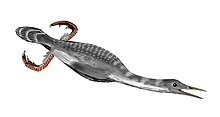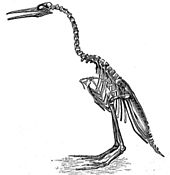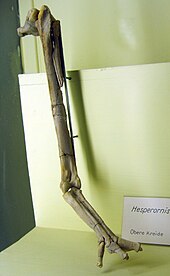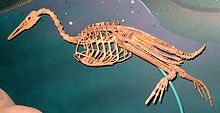
Hesperornithes is an extinct and highly specialized group of aquatic avialans closely related to the ancestors of modern birds. They inhabited both marine and freshwater habitats in the Northern Hemisphere, and include genera such as Hesperornis, Parahesperornis, Baptornis, Enaliornis, and Potamornis, all strong-swimming, predatory divers. Many of the species most specialized for swimming were completely flightless. The largest known hesperornithean, Canadaga arctica, may have reached a maximum adult length of 2.2 metres (7.2 ft).

Edmontosaurus, with the second species often colloquially and historically known as Anatosaurus or Anatotitan, is a genus of hadrosaurid (duck-billed) dinosaur. It contains two known species: Edmontosaurus regalis and Edmontosaurus annectens. Fossils of E. regalis have been found in rocks of western North America that date from the late Campanian age of the Cretaceous period 73 million years ago, while those of E. annectens were found in the same geographic region from rocks dated to the end of the Maastrichtian age, 66 million years ago. Edmontosaurus was one of the last non-avian dinosaurs to ever exist, and lived alongside dinosaurs like Triceratops, Tyrannosaurus, Ankylosaurus, and Pachycephalosaurus shortly before the Cretaceous–Paleogene extinction event.

Ichthyornis is an extinct genus of toothy seabird-like ornithuran from the late Cretaceous period of North America. Its fossil remains are known from the chalks of Alberta, Alabama, Kansas, New Mexico, Saskatchewan, and Texas, in strata that were laid down in the Western Interior Seaway during the Turonian through Campanian ages, about 95–83.5 million years ago. Ichthyornis is a common component of the Niobrara Formation fauna, and numerous specimens have been found.

Struthiomimus, meaning "ostrich-mimic", is a genus of ornithomimid dinosaurs from the late Cretaceous of North America. Ornithomimids were long-legged, bipedal, ostrich-like dinosaurs with toothless beaks. The type species, Struthiomimus altus, is one of the more common, smaller dinosaurs found in Dinosaur Provincial Park; their overall abundance—in addition to their toothless beak—suggests that these animals were mainly herbivorous or omnivorous, rather than purely carnivorous. Similar to the modern extant ostriches, emus, and rheas, ornithomimid dinosaurs likely lived as opportunistic omnivores, supplementing a largely plant-based diet with a variety of small mammals, reptiles, amphibians, insects, invertebrates, and anything else they could fit into their mouth, as they foraged.
Odontornithes is an obsolete and disused taxonomic term proposed by Othniel Charles Marsh for birds possessing teeth, notably the genera Hesperornis and Ichthyornis from the Cretaceous deposits of Kansas.
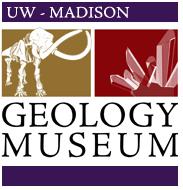
The UW–Madison Geology Museum (UWGM) is a geology and paleontology museum housed in Weeks Hall, in the southwest part of the University of Wisconsin–Madison campus. The museum's main undertakings are exhibits, outreach to the public, and research. It has the second highest attendance of any museum at the University of Wisconsin–Madison, exceeded only by the Chazen Museum of Art. The museum charges no admission.

Gansus is a genus of aquatic birds that lived during the Aptian age of the Early Cretaceous (Aptian-Albian) period in what are now Gansu and Liaoning provinces, western China. The rock layers from which their fossils have been recovered are dated to 120 million years ago. It was first described in 1984 on the basis of an isolated left leg. It is the oldest-known member of the Ornithurae, the group which includes modern birds (Neornithes) and extinct related groups, such as Ichthyornis and Hesperornithes.

Ichthyornithes is an extinct group of toothed avialan dinosaurs very closely related to the common ancestor of all modern birds. They are known from fossil remains found throughout the late Cretaceous period of North America, though only two genera, Ichthyornis and Janavis, are represented by complete enough fossils to have been named. Ichthyornitheans became extinct at the Cretaceous–Paleogene boundary, along with enantiornitheans, all other non-avian dinosaurs, and many other animal and plant groups.

Nyctosaurus is a genus of nyctosaurid pterosaur from the Late Cretaceous period of what is now the Niobrara Formation of the mid-western United States, which, during the time Nyctosaurus was alive, was covered in an extensive shallow sea. Some remains belonging to a possible Nyctosaurus species called N.lamegoi have been found in Brazil, making Nyctosaurus more diverse. The genus Nyctosaurus has had numerous species referred to it, though how many of these may actually be valid requires further study. At least one species possessed an extraordinarily large antler-like cranial crest.

Baptornis is a genus of flightless, aquatic birds from the Late Cretaceous, some 87-80 million years ago. The fossils of Baptornis advenus, the type species, were discovered in Kansas, which at its time was mostly covered by the Western Interior Seaway, a shallow shelf sea. It is now known to have also occurred in today's Sweden, where the Turgai Strait joined the ancient North Sea; possibly, it occurred in the entire Holarctic.
Polarornis is a genus of prehistoric bird, possibly an anserimorph. It contains a single species Polarornis gregorii, known from incomplete remains of one individual found on Seymour Island, Antarctica, in rocks which are dated to the Late Cretaceous.

Benjamin Franklin Mudge was an American lawyer, geologist and teacher. Briefly the mayor of Lynn, Massachusetts, he later moved to Kansas where he was appointed the first State Geologist. He led the first geological survey of the state in 1864, and published the first book on the geology of Kansas. He lectured extensively, and was department chair at the Kansas State Agricultural College.

Edmontosaurus regalis is a species of comb-crested hadrosaurid dinosaur. Fossils of E. regalis have been found in rocks of western North America that date from the late Campanian age of the Cretaceous Period 73 million years ago, but it may have possibly lived into the early Maastrichtian.

Apatornis is a genus of ornithuran dinosaurs endemic to North America during the late Cretaceous. It currently contains a single species, Apatornis celer, which lived around the Santonian-Campanian boundary, dated to about 83.5 million years ago. The remains of this species were found in the Smoky Hill Chalk of the Niobrara Formation in Kansas, United States. It is known from a single fossil specimen: a synsacrum, the fused series of vertebrae over the hips.

Parahesperornis is a genus of prehistoric flightless birds from the Late Cretaceous. Its range in space and time may have been extensive, but its remains are rather few and far between, at least compared with its contemporary relatives in Hesperornis. Remains are known from central North America, namely the former shallows of the Western Interior Seaway in Kansas. Found only in the upper Niobrara Chalk, these are from around the Coniacian-Santonian boundary, 85–82 million years ago (mya).
Limenavis is a genus of ornithuran dinosaurs from the Late Cretaceous. It lived about 70 million years ago, around the Campanian-Maastrichtian boundary. Known from several broken bones, the remains of the only known species Limenavis patagonica were found in rocks of the "lower member" of the Allen Formation at Salitral Moreno, 20 km south of General Roca, Río Negro (Argentina). It is one of the closest relatives, in the fossil record, of the modern birds.
Canadaga is a flightless bird genus from the Late Cretaceous. The single known species is Canadaga arctica. It lived in the shallow seas around what today is Bylot and Devon Islands in Nunavut, Canada. Its fossils were found in rocks dated to the Campanian to mid-Maastrichtian age, about 67 million years ago.

During most of the Late Cretaceous the eastern half of North America formed Appalachia, an island land mass separated from Laramidia to the west by the Western Interior Seaway. This seaway had split North America into two massive landmasses due to a multitude of factors such as tectonism and sea-level fluctuations for nearly 40 million years. The seaway eventually expanded, divided across the Dakotas, and by the end of the Cretaceous, it retreated towards the Gulf of Mexico and the Hudson Bay. This left the island masses joined in the continent of North America as the Rocky Mountains rose. From the Cenomanian to the end of the Campanian ages of the Late Cretaceous, Appalachia was separated from the rest of North America. As the Western Interior Seaway retreated in the Maastrichtian, Laramidia and Appalachia eventually connected. Because of this, its fauna was isolated, and developed very differently from the tyrannosaur, ceratopsian, hadrosaurid, pachycephalosaur and ankylosaurid dominated fauna of the western part of North America, known as "Laramidia".
Iaceornis is a genus of marine ornithuran dinosaurs closely related to modern birds. It was endemic to North America during the Late Cretaceous, living about 83.5 million years ago. It is known from a single fossil specimen found in Gove County, Kansas (USA), and consisting of a partial skeleton lacking a skull.

Tingmiatornis is a genus of flighted and possibly diving ornithurine dinosaur from the High Arctic of Canada. The genus contains a single species, T. arctica, described in 2016, which lived during the Turonian epoch of the Cretaceous.

